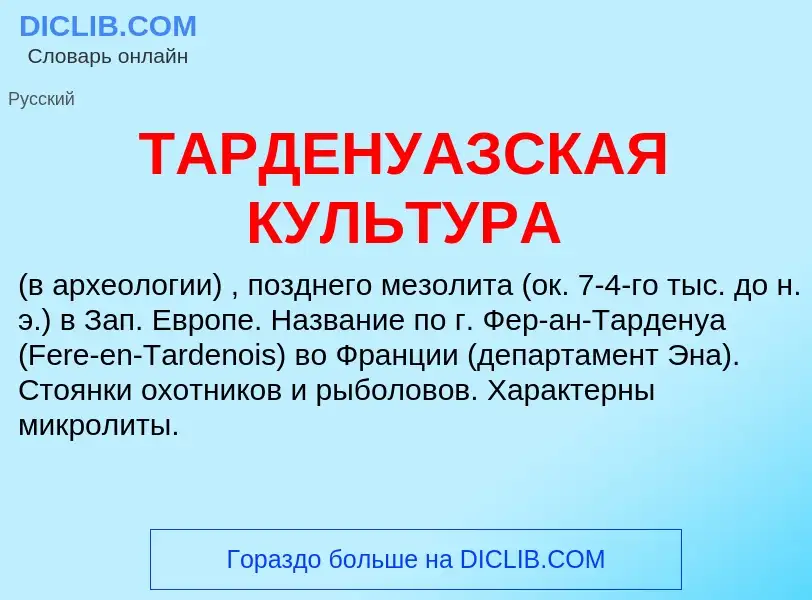Enter a word or phrase in any language 👆
Language:
Translation and analysis of words by artificial intelligence
On this page you can get a detailed analysis of a word or phrase, produced by the best artificial intelligence technology to date:
- how the word is used
- frequency of use
- it is used more often in oral or written speech
- word translation options
- usage examples (several phrases with translation)
- etymology
What (who) is Тарденуазская культура - definition
ТАРДЕНУАЗСКАЯ КУЛЬТУРА
(в археологии) , позднего мезолита (ок. 7-4-го тыс. до н. э.) в Зап. Европе. Название по г. Фер-ан-Тарденуа (Fere-en-Tardenois) во Франции (департамент Эна). Стоянки охотников и рыболовов. Характерны микролиты.
Тарденуазская культура
археологическая культура эпохи позднего Мезолита, 7-4-го тысячелетия до н. э. Получила название от стоянок в окрестностях г. Фер-ан-Тарденуа (La Fère-en-Tardenois) на С. Франции (департамент Эна). Выделена Г. Мортилье в 1896. Распространена, кроме Франции, в Бельгии, Англии, ФРГ. Культуры, близкие к Т. к., распространены в позднем мезолите также в Центральной Европе и Европейской части СССР. В развитии Т. к. Франции выделяют 3 этапа. Позднейший из них относится уже к раннему неолиту и характеризуется появлением примитивной керамики и домашних животных. Стоянки Т. к. располагались главным образом на песчаных холмах и принадлежали подвижным группам первобытных охотников, рыболовов и собирателей, вооружённых луком и стрелами. Богатый могильник Т. к. раскопан на острове Тевьек. Для инвентаря Т. к. характерны так называемые микролиты - миниатюрные (1-2 см в поперечнике) кремнёвые орудия геометрических очертаний (в форме трапеции, треугольника, сегмента, круга и т. д.). Они служили наконечниками стрел и вкладышами; в последнем случае микролиты вставлялись в продольные пазы различных деревянных и костяных орудий и закреплялись с помощью смолы.
Лит.: Монгайт А. Л., Археология Западной Европы. Каменный век, М., 1973.
П. И. Борисковский.
Культура террамар
Культура террамар(е), Террамары (, , ) — археологическая культура бронзового века, существовавшая в Северной Италии в долине реки По. Расцвет приходился на вторую половину 2-го тысячелетия до н.
Wikipedia
Тарденуазская культура
Тарденуазская культура — западноевропейская мезолитическая культура 7—4 тысячелетий до н. э.


 близ г. Парма в Италии.jpg?width=200)
.jpg?width=200)
